Introduction of Chandrayaan-4
Chandrayaan-4 stands as a significant milestone in India’s ambitious lunar exploration program, marking the nation’s first attempt at a Moon sample return mission. Managed by the Indian Space Research Organization (ISRO), this mission is poised to elevate India’s stature in global space exploration by retrieving and returning lunar samples for advanced study on Earth.
Mission Overview of Chandrayaan-4
Mission Objective: To bring back lunar rock and soil samples from the Moon’s south polar region to Earth for detailed scientific analysis. This will help deepen our understanding of the Moon’s composition, history, and resources.
Launch Timeline: Scheduled for launch between 2027 and 2028, after receiving final design approval and funding in 2024.
Budget: Approved funding of ₹2,104.06 crore (approximately $250 million).
Key Features and Technology
Modular Spacecraft Design for Chandrayaan-4
Chandrayaan-4 utilizes an unprecedented modular assembly:
| Module | Function |
|---|---|
| Propulsion Module | Transports the spacecraft from Earth’s orbit to Moon’s orbit |
| Descender Module | Performs the lunar landing and collects surface samples |
| Ascender Module | Launches from the Moon carrying samples to lunar orbit |
| Transfer Module | Transfers collected samples to the re-entry capsule |
| Re-entry Module | Returns safely to Earth with lunar samples inside |
Dual Launch Architecture: Two separate launches with ISRO’s LVM-3 rocket due to the mission’s high payload (~9,200 kg).
In-orbit Docking: Modules will be docked in Earth orbit before heading to the Moon, showcasing advanced space assembly and docking techniques.
Mission Procedure
- Launch Phase: Two rockets will separately deploy five modules into Earth orbit.
- Assembly: The modules are docked in space to form an integrated lunar spacecraft.
- Lunar Descent: The Propulsion Module ferries the craft to lunar orbit, after which the Descender and Ascender Modules separate and soft-land on the Moon near the south pole.
- Sample Collection: Robotic arms and drilling mechanisms gather 2–3 kg of lunar surface and subsurface samples, which are then sealed to prevent contamination.
- Ascent and Transfer: The Ascender Module lifts off from the Moon, docks with the Transfer and Re-entry Modules in lunar orbit, and hands off the samples.
- Earth Return: The Re-entry Module returns the samples to Earth safely for scientific study, utilizing shielding for atmospheric re-entry.
Scientific Implications
New Discoveries: Analysis of untouched lunar material can reveal information on the Moon’s geology, water content, and resource potential.
Global Significance: Only the USA, Russia, and China have executed successful lunar sample-return missions; Chandrayaan-4 aims to place India among this elite group.
Future Missions: This mission is a technological prerequisite for prospective Indian human missions to the Moon by 2040.
Conclusion
ISRO’s Chandrayaan-4 is poised to be one of the most complex and high-stakes lunar missions India has ever undertaken. With advanced modular design, dual launch strategy, and space docking, this Moon sample return mission signals India’s growing expertise in space science and its readiness for future lunar and interplanetary explorations.
Frequently Asked Questions
1. Why is Chandrayaan-4 significant for India?
It aims to return lunar samples and pave the way for potential human spaceflight missions.
2. How is sample return achieved?
By utilizing two launches, modular in-space assembly, robotic collection, and secure re-entry procedures.
3. When will Chandrayaan-4 be launched?
The mission is slated for a launch between 2027 and 2028, depending on technical readiness and approval.
4. What will scientists gain from the returned samples?
Unprecedented insight into the Moon’s composition, resource potential, and history, advancing both Indian and global lunar science.
Stay updated with ISRO for further announcements regarding Chandrayaan-4 and its role in shaping humanity’s lunar future.
